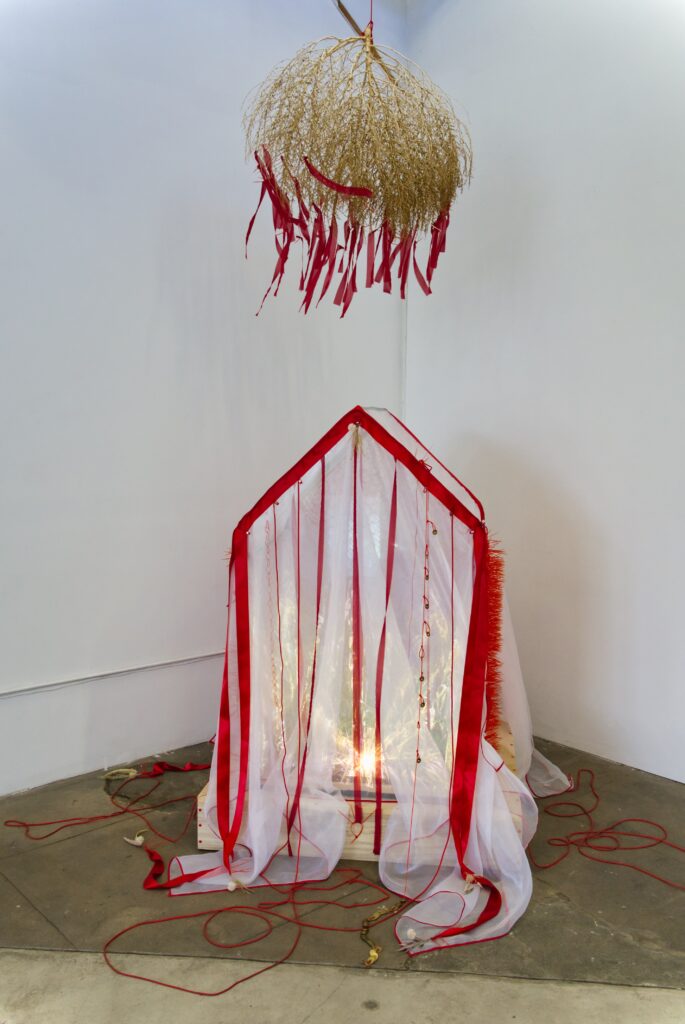Time From Other Places – Carried by Windswept at Wonzimer Gallery by Juri Koll

Wind is potent and prescient, bringing time to us from other places, in precious moments we feel, see, smell. With this in mind, Genie Davis has curated an excellent new show, Windswept, at Wonzimer (a great space and crew) opening on March 21.
Windswept builds on 15 works from international artist’s Susan Ossman’s career as a painter with 14 other artists’ work of equally formidable insight and acumen. These works allow us to be in the moment, to stop and look at the fleeting, illusory elements, the bits and pieces we’re all made of.

Ossman’s “Pin The Wind,” represents for this writer the origin of the concept Davis has so adeptly assembled here. Made up of 2 panels that look as if they are 3, the beautiful and momentary view of sky blue above protects the orange under it, illuminates the earthy feel of each edge, and allows us to be here with it.

Motion, flow, and lush color combine in each of Ossman’s works, creating the sensation of a wind made of color and contrasts, including the wild wind that emanates from her “Dark Winds,” an astonishing oil and linen work that was created specificially for this exhibition.

Angelica Sotiriou’s collage “The Sound of Breath,” like much of her work, brings the moment forward with her free, open command of the brush and the elements she uses that sparkle, layer, and reach toward us, while Bruce Cockerill’s photograph, “Tumbleweed Sky,” below, is fleeting, transitory and yet starkly “now” as a photograph.


Diane Cockerill’s photographic image “Flurry” uses stop-motion technique to capture an image that makes you wait to see what happens next, and gives time and voice to the birds in flight.

“The Answer My Friend (Blowing in the Wind),” is Beth Elliott’s sculptural work, which brings a challenging number of physical elements to an equally challenging subject. How do we hold the fort, and keep the sail aloft, as it were, in a windstorm? How do we remember the things that might be taken away from us when forces out of our control overtake us? The cyanotype element, like a flag, makes us hope we do remember, and that the image will survive.
Each of the other works in this show deserve study, and equally anchor the show, the concept, and the time spent with it, including newly created installations by Dani Dodge, Snezana Saraswati Petrovic, and Jason Jenn, each utilizing a variety of different elements, including, in one case, an actual tumbleweed.

Clouds, also windswept, as depicted utilizing recycled plastics from Nancy Voegeli-Curran, above.
The winds of personal change are a central part of Nancy Kay Turner‘s work, below.

There are also neon works that relate to the recent catastrophic windstorms in LA from Linda Sue Price, along with sculptural works that seem to have arrived as if carried by the wind from Scott Meskill and Eileen Oda, among the many fine artists exhibiting. In many ways, this entire exhibition is a wind-blown surprise.
In all, this immersive group exhibition features painted works by Susan Ossman in conjunction with sculptural, photographic, collage, video, and installation works by artists including Dani Dodge, Angelica Sotiriou, Beth Elliott, Linda Sue Price, Snezana Saraswati Petrovic, Diane Cockerill, Bruce Cockerill, Scott Meskill, Eileen Oda, Jason Jenn, Nancy Kay Turner, Nancy Voegeli-Curan, and a video work from David Isakson. The show explores each artist’s own unique vision of wind, from oil and acrylic to otherworldly mixed media.
Don’t miss the opening Friday, March 21 from 5 to 10 p.m., or the artist’s talk scheduled for Sunday, March 30 at 3 -5 p.m. The show closes with a curatorial walk through on Thursday, April 17 with the gallery open all day and the walk through scheduled for 6 to 8 p.m. Regular gallery hours are 12-7 W-Sun, March 21 through April 20th. Go see it.
Wonzimer Gallery is located at 341-B S Avenue 17, Los Angeles, CA 90031 Website: https://www.wonzimer.com/
- Juri Koll, VICA; photos by Genie Davis and as provided by the artists












































































